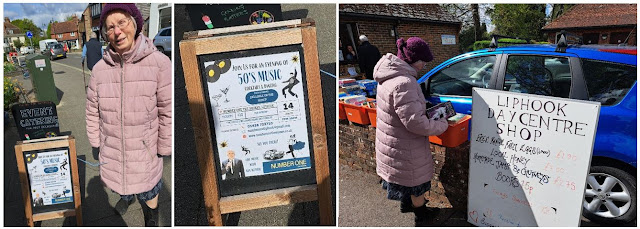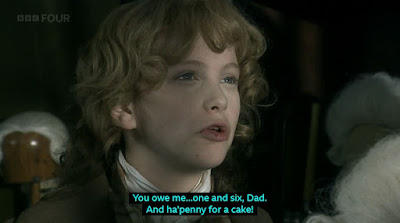Yes, friends, do you wish you'd decided to become a famous artist, rather than the job you finally found yourself ending up in?
I was quite the budding genius with "le crayon" at primary school, but never pursued my talent in later years, although I still like a leave a few tantalising hints to my family members of what might have been, if I hadn't become just another deskbound medium-to-top-secret-agent, as you do (!).
I'm particularly good at "adding value" artistically, improving the work of other artists and photographers, and I'm famous in our family for "cheering up" some of the grim faces of actors we see on the cover of the Radio Times: these usually depict characters from many of the grim TV drama series that my medium-to-long-suffering wife Lois and I typically don't watch, because we're watching some "poncey" documentary on another channel. Just saying!!!
my version of a recent Radio Times cover picture,
making two stars of post-apoplectic [sic] drama
"The Last of Us" look a bit less grim and
maybe a bit more thoughtful at the same time?
I wonder......!
What I didn't know, till our copy of Onion News Local "plopped" through mine and Lois's letterbox this morning, is that this form of "value-added-art" is something of a "thing" these days, it's become an actual '
genre', although this fact has apparently not yet been picked up on by the TV Art Documentaries Brigade, currently "fronted" by Suzy Klein, the BBC's Head of Arts ad Classical Music.
Well, "Wake up, little Suzy!", as the Everly Brothers once famously sang (!).
And my specialty has become a whole school art, particularly the "eye patch school", that we discuss later in the morning with Lois's stylist Anna, when I take Lois in for her haircut this morning, and we all have a good laugh about it, which is nice.
flashback to earlier today: Lois has her hair cut and styled
by young local Liphook (Hampshire) stylist Anna
Lois explains to Anna that she is still having to pin her hair back at the moment - she had a cataract operation exactly 2 weeks ago at the Optegra Eye Hospital at nearby Guildford, Surrey, and she still needs to keep things like stray strands of hair out of her eyes. However, after 2 weeks, Lois tells Anna that she no longer needs to wear an eye-patch, and I overhear both women agreeing that "having to wear an eye patch is 'the fun part' of any eye operation".
What madness!!!! But it makes me wonder - would Lois like me more if I wore an eye-patch? Bowie famously pulled it off, or rather "kept it on" (!), but would it be really "me"?
Colin Bowie
Your views please - postcards only!
11:00 After Lois's haircut, we have a typical "old codgers" walk around Liphook, browsing through some boxes of random second-hand books outside the Daycare Centre, then thinking about getting tickets for the Old Codgers 1950's Rock'n'Roll Nite [sic], then looking at some of Liphook's old cottages, and then finally ending up doing a walk round the local "rec" (recreation ground) .
We're two of Liphook's newest residents, having moved here just 3 months ago, so there is still a lot of the town for us to explore, to put it mildly.
And if YOU too are an old codger, Liphook couldn't be a better place to walk round, particularly if you like to be surrounded by other old codgers, let me tell YOU!
some of the old cottages of Liphook, that Lois and I look round this morning:
(right) me showcasing the old Tap House (tavern) that dates back to the 16th century
Liphook seems like a leafy, semi-rural backwater now, but it's played its part in history, because it was halfway between London and Portsmouth, and so a favourite staging post for coaches often carrying naval men.
Admiral Lord Horatio Nelson stopped here at the Royal Anchor Inn, on his way down to Portsmouth, before sailing out to defeat the French and Spanish fleets at the Battle of Trafalgar in 1805.
And after the war against Napoleon was won, in 1815, the crowned heads of Europe met Britain's Prince of Wales at the Royal Anchor, to discuss ways of "making the world safe for monarchy".
the crowned heads of Europe, seen here at Vienna in 1814
But don't think Liphook was just reserved for reactionaries - oh no!
The town's Royal Anchor Inn was also radical firebrand journalist John Wilkes MP's favourite drinking-hole, if he fancied a "swift half" or three (!). Wilkes, the MP for Middlesex, famously fought for the rights of the press, including the right to report Parliamentary debates verbatim, and also supported the rebel side in the American War of Independence.
flashback to 1768: John Wilkes, Radical MP for Middlesex,
famously fond of downing a "swift half" at Liphook's Royal Anchor Inn
[That's enough potted history! - Ed]
And when evening comes, and Lois and I finally settle down on the couch together, I've got to say that my own "artistic skills", such as they are - drawing smiles and eye-patches etc on faces on magazine covers - are, I have to say, to some extent put into perspective by an interesting TV drama-documentary on artist JMW Turner (1775-1851). [That's big of you, Colin! - Ed]
We're in luck too, because the snooker doesn't overrun - saints preserve us if snooker-fans have to miss one of their snooker idols pocketing a ball, and then being made to put it back on the table, or something similar !!!! Just saying !!!!!!
Lois and I didn't realise that Turner was brought up in Covent Garden, then a pretty rough, but lively area of London, where his father was a barber and kept a little shop amid all the street-markets and brothels.
William and his father were both keen artists and also keen to get a good price for their paintings, as well as both being famously "tight" with money.
The young William liked to get away from London whenever he got the chance to stay with any of his country cousins. Aged 10, he went to stay with his aunt at Brentford, Essex, then a rural idyll. A friend spotted the lad's artistic talents and got him to "colour in" some of the pictures in a book - and the book is still preserved, and kept in Brentford Library. Some of the pictures, however, were "unsuitable for a 10-year-old", according to the librarian. Oh dear!
And it's ironic that, while Turner is best known for his landscapes, it's less well-known that he also enjoyed painting or sketching women.
After becoming an established artist he moved to Harley Street, in a more fashionable part of London, and found love in the person of Sarah Danby, a young widow with 4 children. Danby then subsequently gave birth to a further two daughters, this time fathered by Turner, although he never acknowledged them for some reason. And Turner liked nothing better than to sketch Danby in various affectionate, intimate poses
We don't have all of Turner's intimate sketches of women, however, because after he died, his friend the art critic John Ruskin destroyed most of them, to preserve Turner's so-called "reputation". What a crazy world they lived in, back in those far-off days!
It's noteworthy also that while Turner's contemporary John Constable barely left his native county of Suffolk, Turner travelled widely in Europe, taking advantage of the peace that followed Wellington's victory over Napoleon at the Battle of Waterloo.
From the French Revolution in 1789 to Waterloo in 1815, British citizens were "personae non gratae" (and note the somewhat 'poncey' plural there, sports fans!!!) on the European continent, so it was a welcome relief for moneyed Brits to be able to visit places like Venice, and to feel a bit of the sun's warmth after 16 years of British winters, to put it mildly!
[Oh just go to bed! - Ed]
22:00 We go to bed - zzzzzzz!!!!!








































No comments:
Post a Comment